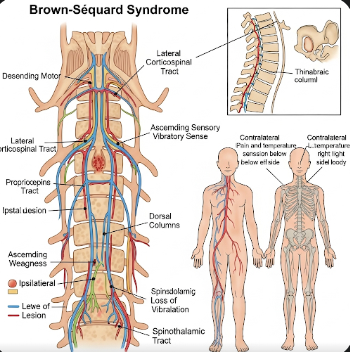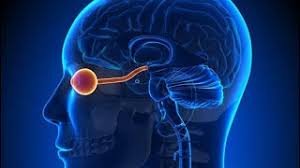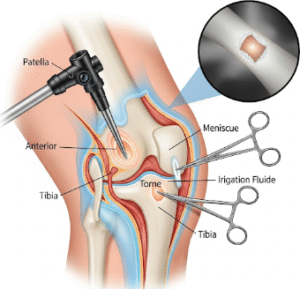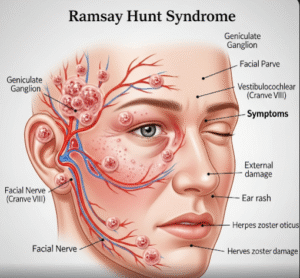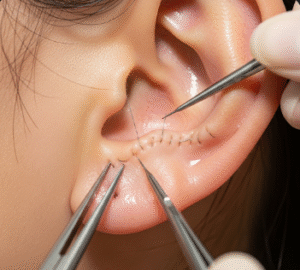Overview
Brown-Séquard Syndrome (BSS) is a rare neurological condition resulting from hemisection or injury to one side of the spinal cord, leading to distinctive patterns of motor, sensory, and autonomic deficits. This condition often arises from trauma, tumors, infections, or vascular events affecting the spinal cord.
In Korea, BSS is managed in neurology, neurosurgery, and spinal rehabilitation centers, where patients receive accurate diagnosis, surgical and medical treatment, and long-term rehabilitation. Korean healthcare emphasizes early intervention, precise imaging, and multidisciplinary rehabilitation to maximize functional recovery and minimize complications.
What is Brown-Séquard Syndrome?
Brown-Séquard Syndrome occurs when one half of the spinal cord is damaged, disrupting motor and sensory pathways:
- Ipsilateral (same side) motor loss due to corticospinal tract damage
- Ipsilateral loss of proprioception, vibration, and fine touch
- Contralateral (opposite side) loss of pain and temperature sensation due to spinothalamic tract involvement
BSS can affect cervical, thoracic, or lumbar spinal cord levels, and the severity of symptoms depends on the extent and level of injury.
Symptoms
Symptoms typically present in a distinctive pattern:
- Weakness or paralysis on the same side as the lesion
- Loss of fine touch, vibration, and position sense on the same side
- Loss of pain and temperature sensation on the opposite side
- Spasticity or increased muscle tone below the lesion
- Bladder and bowel dysfunction in severe cases
- Muscle atrophy over time if nerve damage is prolonged
The onset of symptoms may be sudden after trauma or gradual in cases of tumors or chronic compression.
Causes
Brown-Séquard Syndrome can result from various spinal cord injuries or conditions:
- Traumatic spinal cord injury, including stab wounds, gunshot injuries, or fractures
- Spinal cord tumors, such as meningiomas or ependymomas
- Ischemic events affecting the spinal cord blood supply
- Infections like tuberculosis or viral myelitis
- Multiple sclerosis or other demyelinating diseases
- Disc herniation or degenerative spinal conditions causing unilateral compression
Risk Factors
- Spinal trauma from accidents or falls
- Penetrating injuries, including knife or bullet wounds
- Spinal degenerative conditions in older adults
- History of spinal surgery or interventions
- Underlying neurological disorders such as multiple sclerosis
- Vascular conditions that compromise spinal cord perfusion
Complications
If untreated, Brown-Séquard Syndrome can lead to:
- Permanent paralysis or motor deficits
- Chronic sensory deficits, including numbness and loss of sensation
- Spasticity and abnormal muscle tone
- Bladder and bowel dysfunction
- Chronic pain syndromes
- Reduced mobility and dependence on caregivers
Early diagnosis and intervention are critical to maximize functional recovery and prevent secondary complications.
Prevention
Preventive strategies focus on reducing spinal cord injury and managing underlying conditions:
- Using safety measures such as seat belts, helmets, and fall prevention
- Prompt treatment of spinal infections or tumors
- Avoiding risky activities that may cause penetrating injuries
- Maintaining spinal health through proper posture and ergonomics
- Monitoring chronic conditions like degenerative disc disease for early intervention
Treatment Options in Korea
Diagnosis
Diagnosis of BSS relies on clinical examination and advanced imaging:
- Neurological assessment to evaluate motor and sensory deficits
- Magnetic Resonance Imaging (MRI) for detailed visualization of spinal cord lesions
- Computed Tomography (CT) scan to assess fractures or bone involvement
- Electrophysiological studies such as somatosensory evoked potentials
- Laboratory tests to identify infections or inflammatory causes
Medical Management
Medical treatment is tailored to address the underlying cause and manage symptoms:
- Corticosteroids to reduce inflammation in acute spinal cord injury
- Antibiotics or antivirals for infectious causes
- Immunotherapy for autoimmune-related spinal cord involvement
- Pain management, including medications and nerve blocks
- Bladder and bowel care to prevent complications
Surgical Management
Surgery may be required in cases of:
- Traumatic spinal cord compression
- Spinal tumors or abscesses
- Herniated discs causing unilateral cord compression
Korean neurosurgery centers employ minimally invasive spinal techniques, precision decompression, and stabilization procedures to preserve spinal cord function.
Rehabilitation and Support
Rehabilitation is essential for functional recovery:
- Physical therapy to improve strength, coordination, and mobility
- Occupational therapy to assist with daily living activities
- Assistive devices, such as braces or mobility aids
- Neurorehabilitation programs for balance, gait, and fine motor skills
- Psychological support to address emotional and mental health challenges
Prognosis
The prognosis of Brown-Séquard Syndrome depends on:
- Severity and extent of spinal cord injury
- Level of the lesion (cervical lesions often have more profound effects)
- Promptness of treatment
- Patient age and overall health
In Korea, early intervention, specialized neurosurgical care, and multidisciplinary rehabilitation significantly improve outcomes:
- Many patients regain partial to full motor function on the affected side
- Sensory deficits may persist, but adaptive strategies can improve quality of life
- Ongoing rehabilitation helps maintain mobility, strength, and independence
- Advanced spinal care minimizes long-term complications and promotes recovery
With state-of-the-art imaging, expert neurosurgeons, and comprehensive rehabilitation services, Korea provides patients with Brown-Séquard Syndrome a higher chance of functional recovery and improved quality of life.

